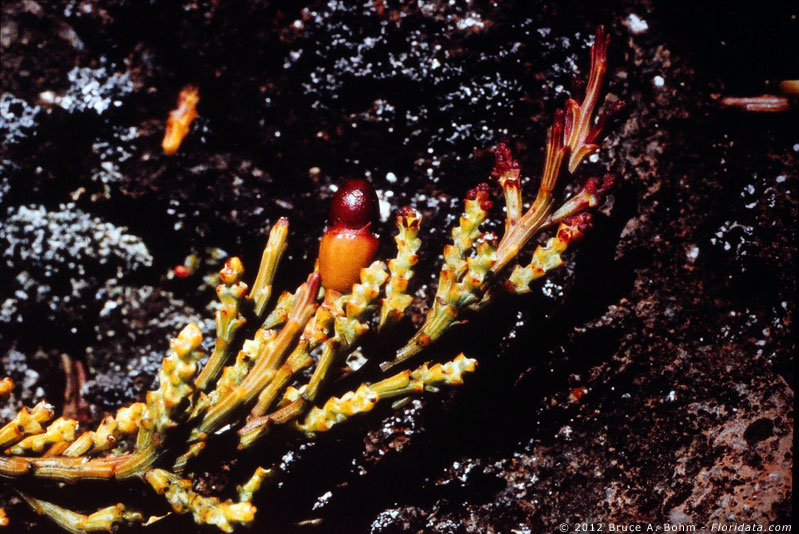
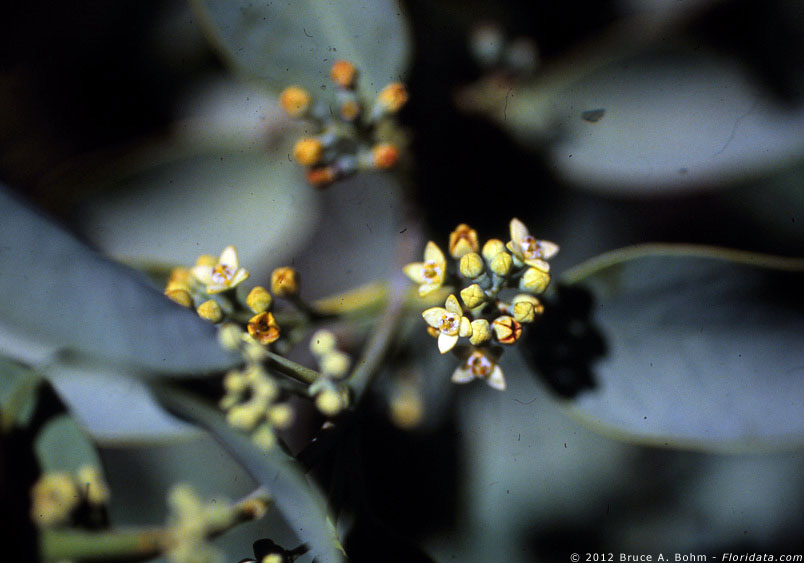


Santalaceae, the sandalwood family, contribute seven endemic species to the Hawaiian flora, three in the genus Exocarpus, four in Santalum. Santalaceae have grown in recent years with the inclusion of Viscaceae, the family to which the mistletoes belong. (We will meet the Hawaiian mistletoes below in the section on Viscaceae.) Thus, the Manual describes Santalaceae as consisting of 400 species in 35 genera, whereas Mabberley's listing (p. 765) has the numbers at 44 genera with 875 species. The family, however constituted, consists of hemiparasitic shrubs or trees typically found in the tropics or warm dry regions, although some parasitic members do thrive in damper, temperate zones as well.
Exocarpos is a genus of 26 species with centers of diversity in Australia, where nine of the continent's 10 species are endemic, and New Caledonia with five species, with the others distributed in southeastern Asia and Malesia (Mabberley, p. 330). Three species occur in the Hawaiian Islands. The only member of this set that I have seen is E. menziesii (see image) a specimen of which we found at about 7,200' (ca. 2,200 m) elevation on the trail to Mauna Loa on the Big Island. (There is also a Maunaloa on Moloka`i.) Hawaiians call all members of the genus heau or au.
Sandalwood, `iliahi, la`au `ala (literally, sweet wood), among others, in Hawaiian, has an impressive history. Sandalwood has been in cultivation in southeast Asia for many centuries owing to the importance of the wood for religious purposes–the wood was burned at Buddhist funerals–as well as for its esoteric value in the construction of decorative woodwork and production of essential oil for the perfume industry. Santalum album, a native of India, provided the bulk of the commercial material for a very long time, but increased demand and the profitability of the crop led to extensive harvesting of sandalwood species throughout the Pacific Basin. This led to the extinction of sandalwood (S. fernandezianum) in the Juan Fernandez Islands (Chile) by 1916, its destructive commercialization in the Marquesas (not extinct, but threatened), and its near extinction in the Hawaiian Islands, which will be described in more detail below.
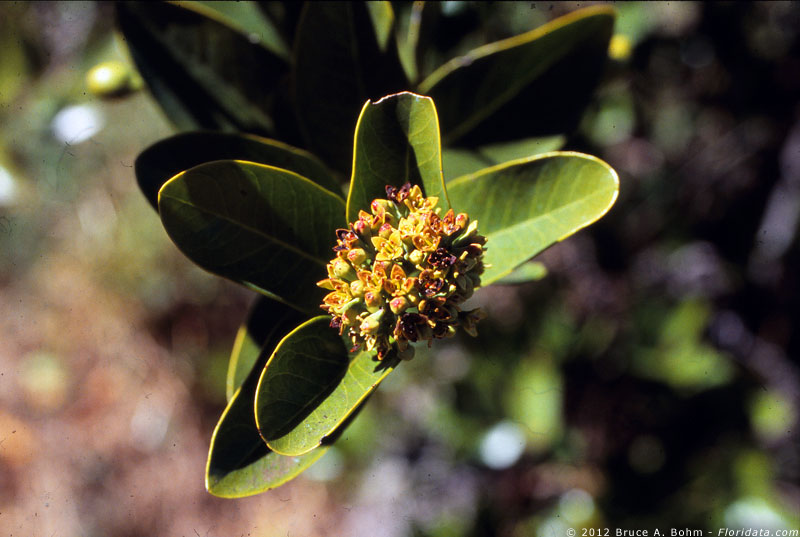

Both the authors of the Manual and Mabberley (p. 765) have the number of species in Santalum at about two dozen. A more recent assessment of the genus by Danica Harbaugh (Harbaugh and Baldwin, 2007) states that the genus "…includes 15 extant species, approximately 14 varieties, and one recently extinct species." Insofar as Harbaugh's work will result in a monograph of the genus, this appears to be the currently acceptable number. Four species are endemic on the Hawaiian Islands. Some Santalum album has been cultivated but has not become naturalized. Santalum ellipticum (see image), the coast sandalwood or `iliahialo`e in Hawaiian, occurs in low elevation, mainly dry habitats on all of the main islands, but is now extinct on Kaho`olawe and Laysan. Santalum paniculatum (see image) occurs at higher elevations on Hawai`i. Santalum haleakalae (see image), as its name implies, is endemic to East Maui. This species can readily be seen in its natural habitat, higher elevation shrub land, along the Halemau`u Trail on Haleakalä, where the photograph was taken. A large specimen can also be found at the far end of the circular nature trail at Hosmer Grove, a camping area just outside the National Park entrance. Santalum freycinetianum (see image) occurs on all of the islands, except Ni`ihau and Kaho`olawe, with varieties having more restricted distributions, for example, var. lanaiense known from Läna`i and Maui. This variety is a smaller form than others as might be expected from the nature of its very dry habitat.

The four endemic sandalwood species can be grouped into two sets of two based upon flower color, ratios of length to width of flowers, and whether the flowers produce nectar. Thus, S. freycinetianum and S. haleakalae have reddish corollas, flowers that are longer than wide, and produce nectar, while S. ellipticum and S. paniculatum have greenish corollas that turn orange, flowers that are about as long as wide, and produce little or no nectar. This differentiation of groups suggests that the island sandalwoods are the result of two independent colonizations. This hypothesis remained untested until recently when Danica Harbaugh, working with Bruce Baldwin at the University of California, Berkeley, used a combination of chloroplast and nuclear gene sequence data to examine relationships among all species in the genus. Her results clearly indicated that the two colonization hypothesis was correct, that both originated from the Austral region, and furthermore, that the colonizations occurred at different times. The S. freycinetianum/S. haleakalae pair arose from a colonization event that occurred about 1.0-1.5 million years ago, and that the ancestor of the S. ellipticum/S. paniculatum pair arrived on the islands about a half million years ago. Both of these events are well within the age range of existing islands.
In addition to establishing multiple colonizations, a comparably rare phenomenon in the history of the Hawaiian flora (seen otherwise in Rubus and Scaevola, blackberries and naupaka, respectively), this study provided another example that the Hawaiian Islands need not be the terminus of transoceanic travels. The data revealed that one, or possibly two, colonizations of the Bonin Islands and eastern Polynesian Islands may have occurred with propagules originating in the Hawaiian Islands. The apparent ease of long distance dispersal of sandalwood propagules would account for representatives of the genus having made the very long journey to the Juan Fernandez Islands in the eastern Pacific Ocean, as well as to most other island groups. Observations described by Dr. Harbaugh in her later paper (2008) may help to explain why the genus is so widespread. She set out to test the hypothesis, which had been discussed in the earlier literature on plant dispersal, that polyploids (species having more than the 'normal' diploid number of chromosomes) are better adapted for long distance dispersal than diploids. Two features of polyploids that may be important are decreased seed size, which would make it easier for birds to transport several at once, and increased endocarp thickness, which would provide greater protection for the contained embryo. Others have suggested that polyploids have higher tolerance for environmental stresses such as the lower nutrient availability found on volcanic islands. Another suggestion is that polyploids would have lowered levels of inbreeding depression, resulting in increased possibility of self fertilization, a critical capacity in the instance where a single individual succeeds in becoming established in the new island setting. Dr. Harbaugh's study showed that the four Santalum species on the Hawaiian Islands, S. boninense on the Bonin Islands, and a variety each of S. insulare on the Society Islands and on the Marquesas were all polyploids. Exceptions are the diploids S. yasi on Fiji, and S. austrocalidonicum on Vanuatu and New Caledonia. It seems as though the sandalwood species on the Juan Fernandez Islands, which would have involved the longest long distance dispersal of any species, had been harvested to extinction before its chromosome number could be determined (Tod Stuessy, personal communication).
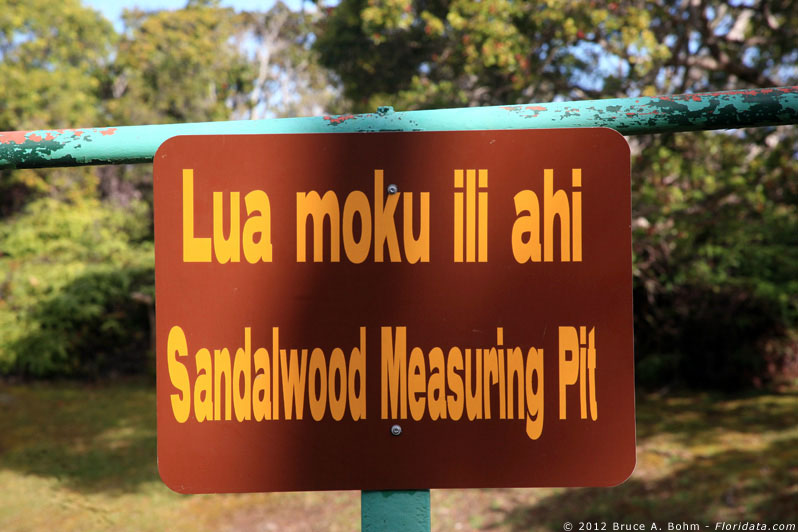
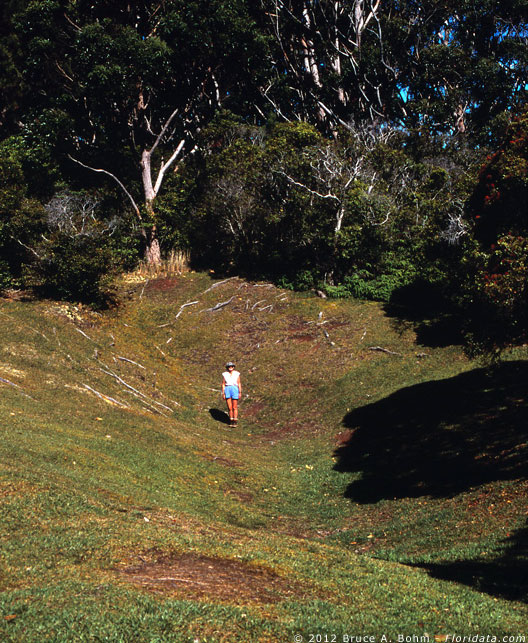
Some time ago I wrote a short article for this website entitled Hawaiian Sandalwood–A Shameful History. The story, in brief , follows. If a single species in the Hawaiian flora were to be selected as representative of the abuse that can be inflicted by humankind upon Nature, and upon fellow humans, it would have to be sandalwood. Species of sandalwood were recognized on the Hawaiian Islands by naturalists who visited the islands in the late 18th century soon after the existence of the archipelago was first reported by a European (Capt. James Cook, who was killed in the islands in 1779, did not "discover" the islands, the voyaging Polynesians did). Harvesting sandalwood (S. freycinetianum) was initiated in 1791 by Capt. John Kendrick, a Boston fur trader who was quick to see the commercial possibilities of the trees, which at that time were quite abundant. In peak harvesting years the number of trees cut was staggering. During the period 1821-1822 1.8 million kilograms, or about four million pounds, of sandalwood were shipped to China. It has been estimated that about 6,000 trees had to be harvested in order to fill one ship.
A shipload was measured by the amount of wood needed to fill a ship's hull sized pit dug in the ground. Such a pit can be seen on Moloka`i (see images), not far from the Waikolu Valley lookout on the Maunahui Road. A visit to the Sandalwood Hull site provides a striking memorial to those harsh times. After the necessary amount of wood had been accumulated, the logs were carried on the bare backs of men, women, and children–sometimes protected by a layer of kapa cloth–to the nearest port, in the case of Moloka`i, a distance of about 20 miles. Many were injured, others were less fortunate. In addition to the suffering caused by this labor, cultivation of food crops was neglected with resulting severe food shortages. Eventually, leaders saw the seriousness of the situation and took corrective measures. By this time, however, sandalwood trees had been harvested from all but the most inaccessible terrain. Fortunately, seedlings, whose heartwood had not yet accumulated useful amounts of aromatic oil, were spared. With the disappearance of sandalwood, interest soon turned to another species, Myoporum sandwicense (naio, or bastard sandalwood, we saw Myoporaceae above) whose heartwood has an aroma similar to that of sandalwood. The first load of naio was rejected by buyers in China, thus, in all likelihood, saving another Hawaiian species from near extinction.
Fuller accounts of this fascinating period in Hawaiian history can be found in Angela Kay Kepler's book Hawai`i's Heritage Plants; in a 1990 article by Mark Merlin and Dan VanRavenswaay entitled The History of Human Impact on the Genus Santalum in Hawai`i published by the United States Department of Agriculture Forest Service; and in Charles H. Hammatt's journal entitled Ships, Furs, and Sandalwood. A Yankee Trader in Hawai`i, 1823-1825.
Literature cited…
Hammett, Charles H. Ships, Furs, and Sandalwood. A Yankee Trader in Hawai`i, 1823-1825. Edited by Sandra Wagner-Wright. 1999. University of Hawai`i Press, Honolulu
Harbaugh, D. T. 2008. Polyploid and hybrid origins of Pacific Island sandalwoods (Santalum, Santalaceae) inferred from low-copy nuclear and flow cytometry data. International Journal of Plant Science 169: 677-685.
- - - - - - and B. G. Baldwin. 2007. Phylogeny and biogeography of the sandalwoods (Santalum, Santalaceae): repeated dispersals throughout the Pacific. Amer. J. Bot. 94: 1028-1040.
Merlin, M. and D. VanRavenswaay. 1990. The History of Human Impact on the Genus Santalum in Hawai`i. USDA Forrest Service Gen. Tech. Rep. PSW-122: 46-60.
September 10, 2012